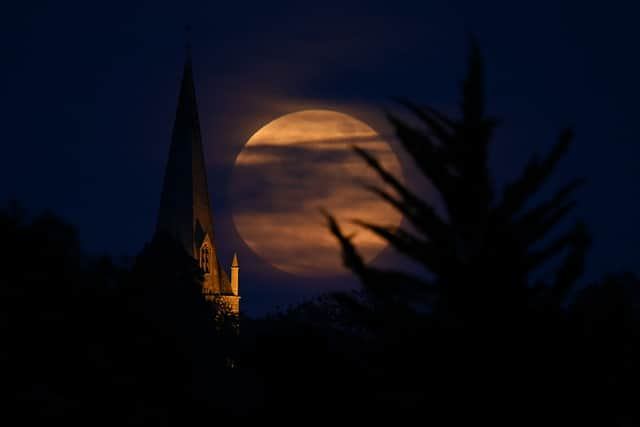Flower Moon 2023: meaning of May full moon explained, date, how to see it, next full moon - weather forecast
and live on Freeview channel 276
This month, stargazers can expect to get a glimpse of the Flower Moon, as the full moon of May rises into the sky.
From ancient folklore to modern day celebrations, the Flower Moon has captured the imaginations of people for centuries.
Advertisement
Hide AdAdvertisement
Hide AdBut what is the best way to make sure you get to see the bright full Moon for yourself, and where does that curious name actually come from? Here is everything you need to know about it.
Why is it known as the ‘Flower Moon’?
The full moon of May is often referred to as the “Flower Moon” because it is the time of year when many flowers are in bloom in the Northern Hemisphere.
The has its origins in the traditions of the Indigenous peoples of the Americas, where each full moon was given a unique name that reflected the natural cycles of the year and the activities that took place during each season. Each name reflected the particular time of year and the cultural practices of the tribe.
The names of the full moons varied from tribe to tribe, as well as regionally across North America. For example, the May full moon was called the Flower Moon by the Algonquin tribes of the northeastern United States.
Advertisement
Hide AdAdvertisement
Hide AdThe Flower Moon name comes from the fact that May is typically the month when spring is in full swing, and many flowers start to bloom, filling the fields and meadows with vibrant colours and fragrances; a poetic and fitting tribute to the beauty of the natural world, and the role that flowers play in the cycle of life.
In some cultures, the May full moon is also called the Corn Planting Moon or Milk Moon, reflecting the importance of agriculture and the start of the planting season.


When can I see it?
In 2023, the full May moon will appear on the evening of Friday 5 May. It will technically be at its “fullest” in the early evening, around 6.30pm, but since the Moon is not expected to rise until around two hours later, it will be tucked firmly below the horizon at this point.
Nonetheless, when the Moon does make its evening appearance (at around 8.30pm), it will still be a spectacular sight.
Advertisement
Hide AdAdvertisement
Hide AdGetting a glimpse of it earlier on when it is closest to the horizon will give the best effect due to an optical illusion known as the “moon illusion,” which occurs because of the way our brains perceive the size of objects in relation to their surroundings.
When the moon is high in the sky, it is often viewed in isolation against a relatively featureless background, such as the darkness of the night sky. This makes it difficult for our brains to judge the moon’s size accurately.
However, when the moon is closer to the horizon, it is often viewed in relation to familiar objects such as buildings, trees or hills, which provide a visual reference for our brains to use in determining the moon’s size.
In addition to this, there is also a relative size illusion at play, where the moon appears larger because of the size contrast with the distant landscape objects. This contrast creates an optical illusion, which makes the moon look much larger than it actually is.
Is it a supermoon?
Advertisement
Hide AdAdvertisement
Hide AdA supermoon is a full or new moon that coincides with the moon’s closest approach to Earth in its orbit, known as its perigee. This makes the moon appear larger and brighter in the sky than a typical full or new moon.
While the difference in size and brightness between a supermoon and a regular full or new moon is subtle, it can still be a stunning sight to behold, particularly when viewed as it rises or sets on the horizon.
Supermoons are not a rare occurrence, as there can be between two to four supermoons in a year. However, this year’s May full moon will not be a supermoon, and we aren’t due one until the full moon of July 2023.
On Monday 3 July, we’ll be treated to the “Super Buck Moon”, named by the Indigenous peoples of the Americas after the antlers that start to appear on male deer during this time.
What will the weather forecast be?
Advertisement
Hide AdAdvertisement
Hide AdOf course, getting the best view of the full moon is heavily reliant on the famously changeable British weather, and clouds are the most common obstacle likely to scupper your chances of viewing it. Unfortunately, at the time of writing (the morning of Thursday 4 May), the Met Office’s forecast for Friday evening isn’t looking too promising.
“Rain, drizzle and low cloud” will affect eastern Scotland during the day, and though it will turn “brighter across England, Wales and Northern Ireland” later on, there is the potential for showers to break out, “some heavy and thundery.”
The forecast provider’s projected weather map does suggest that these showers may be spread quite thin across the country however, and clear skies for the majority of the nation seems likely. Check your local weather forecast nearer the time for a more accurate summation of conditions.
If the weather is cloudy in your area, the next full moon will arrive on Sunday 4 June.
Comment Guidelines
National World encourages reader discussion on our stories. User feedback, insights and back-and-forth exchanges add a rich layer of context to reporting. Please review our Community Guidelines before commenting.
